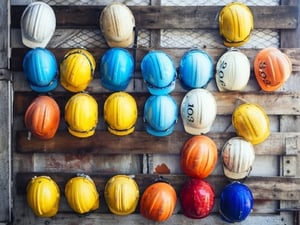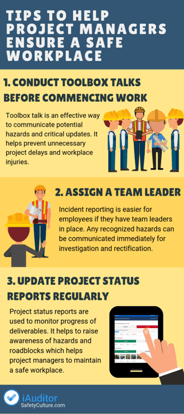 Stakeholders trust project managers at architecture, engineering, and construction firms to carefully plan, design, and execute a team’s strategy to achieve a common goal.
Stakeholders trust project managers at architecture, engineering, and construction firms to carefully plan, design, and execute a team’s strategy to achieve a common goal.
One of their responsibilities is to ensure a safe workplace for their team. A project manager should be able to detect, analyze, and communicate risks that may impact the likelihood of the success of their project.
As a project manager, how can you ensure the safety of your team? What are the things you can do to minimize potential risks? How can you communicate properly with the team as a whole and individually? Below are some effective tips you can follow to ensure everyone is on the same page when it comes to workplace safety.
1. Conduct toolbox talks before commencing work.
A toolbox talk is an effective way to communicate potential hazards and critical updates to your team before they begin the working day. It helps identify issues and increases employee awareness on associated risks for a particular project.
A regular toolbox talk helps prevent unnecessary project delays, miscommunication, and workplace injuries. It helps guide employees on important instructions that may affect their safety and productivity.
2. Assign a team leader.
Managing a big project is difficult if you have to monitor everything by yourself. Assign a team leader to make it easier to communicate and gather information about project status and improvements.
A team leader ensures all information about the project is discussed and acknowledged by their teams. It’s the team leader’s responsibility to confirm if the work itself was carried out according to required standards and report all necessary updates to their project managers.
Incident reporting is easier for employees if they have team leaders in place. Any recognized hazards like loss of materials, equipment defects, and damaged items can be communicated easily and immediately for investigation and rectification.
 3. Update project status reports regularly.
3. Update project status reports regularly.
Project status reports are used to monitor progress of deliverables and determine timelines. It helps evaluate quality of work and allocated budget to keep stockholders informed on the current status of the project.
A RAG (Red, Amber, Green) status rating system is usually used to update project reports. It helps to identify which areas of the project need more time and determines the reasons why a project is not progressing. It also raises awareness of hazards and roadblocks, which helps project managers communicate and maintain a safe workplace for their teams.
Keeping employees safe is the responsibility of every business owner. As part of the management team, it is important to communicate safety precautions to avoid occurence of disastrous accidents. A safe and healthy workplace helps boost employee productivity and efficiency which leads to successful projects.
About the Author: Jona Tarlengco is a content writer for SafetyCulture, a software company that enables businesses to perform inspections using digital checklists. By enhancing the overall digital inspection experience, SafetyCulture has helped companies across the globe enhance efficiency and safety standards by providing intuitive digital checklists for incident reports and others.



